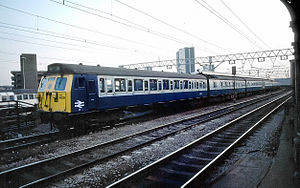British Rail Class 305
| British Rail Class 305 | |
|---|---|

A Class 305 train at platform 8 of Stratford station.
|
|
| In service | 1959 - 2001 |
| Manufacturer | BR York (52 × 305/1)/ Doncaster (19 × 305/2) |
| Order number |
|
| Family name | 1959 EMU |
| Number built | 71 trainsets |
| Formation | 3 or 4 cars per trainset:
|
| Diagram |
|
| Fleet numbers |
|
| Capacity | 272 seats (305/1), 344 2nd + 19 1st (305/2) |
| Operator(s) | |
| Depot(s) | |
| Specifications | |
| Car body construction | Welded steel and spayed asbestos |
| Train length | 199 ft 6 in (60.81 m) (305/1) 265 ft 8 1⁄2 in (80.99 m) (305/2) |
| Car length | 63 ft 6 1⁄2 in (19.37 m) |
| Width | 9 ft (2.74 m) |
| Height | 12 ft 7 in (3.835 m) |
| Doors | Slam |
| Articulated sections | 3 or 4 |
| Wheelbase |
|
| Maximum speed | 75 mph (121 km/h) |
| Weight |
|
| Traction motors | 4 × GEC WT380 of 153 kW (205 hp) |
| Auxiliaries | 240 V from the tertiary winding of the main transformer for heating and for a Westinghouse charger feeding 110v dc for lighting and battery charging |
| Power supply | Mercury-arc rectifiers (later replaced with silicon diode) |
| Train heating | Electric |
| Electric system(s) |
25 kV 50 Hz AC Overhead (and 6.25 kV until 1983) |
| Current collection method | Pantograph |
| Bogies |
|
| Braking system(s) | Westinghouse EP air |
| Safety system(s) | AWS |
| Coupling system | Drophead |
| Multiple working | Within Class only |
| Track gauge | 1,435 mm (4 ft 8 1⁄2 in) standard gauge |
The British Rail Class 305 was an alternating current (AC) electric multiple unit (EMU). Under the pre-1973 British Rail numbering system, the class was known as AM5. When TOPS was introduced, the class became Class 305.
Class 305 had three sub classes:
305/1 units were generally deployed on inner suburban services on the Lea Valley Line out of London Liverpool Street to Chingford, Enfield Town and Hertford East. They mainly worked the Chingford and Enfield branches, where their average scheduled speed was 22 mph (35 km/h). However, they were also used on the Great Eastern lines out of London Liverpool Street and occasionally worked out of their ‘normal’ operating area when coupled to a 305/2 unit or any of the compatible EMUs in use at the time. These units were distinguished by their lower backed seating. 305/1 units were replaced from 1980 onwards by British Rail Class 315 units. They were not generally used elsewhere, but a small number of units, are believed to have operated around Manchester for a brief period in the mid 1990s. All examples of the sub class were scrapped.
305/2 units were generally deployed on outer suburban services on the Lea Valley Line out of London Liverpool Street to Bishops Stortford (the extent of electrification until 1987), where their average scheduled speed was 34 mph (55 km/h). Like the 305/1 units, they could occasionally be seen on other services out of Liverpool Street and were sometimes coupled to other compatible EMUs for multiple working.
...
Wikipedia
